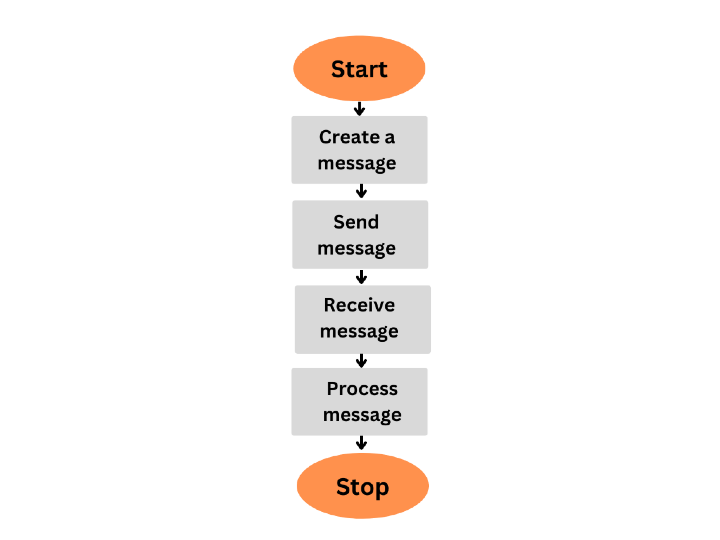
 Data Structure
Data Structure Networking
Networking RDBMS
RDBMS Operating System
Operating System Java
Java MS Excel
MS Excel iOS
iOS HTML
HTML CSS
CSS Android
Android Python
Python C Programming
C Programming C++
C++ C#
C# MongoDB
MongoDB MySQL
MySQL Javascript
Javascript PHP
PHP
- Selected Reading
- UPSC IAS Exams Notes
- Developer's Best Practices
- Questions and Answers
- Effective Resume Writing
- HR Interview Questions
- Computer Glossary
- Who is Who
Message-based Communication in IPC(inter-process communication)
Introduction
Message-based communication (MBC) is a type of communication within a process (IPC) in which multiple procedures share data by sending statements to the other person. The transmission procedure structures an e-mail that included what needs to be passed on and provides it to the process of reception in this form of interpersonal interaction. In turn, the procedure for receiving gets the communication and herbal extracts whatever data is required.
Utilizing memo-based interactions in IPC has multiple benefits. One of the primary benefits is that it offers a simple and adaptable way to facilitate interaction between procedures. Asynchronous programming message sending and receiving allows processes to continue running while they anticipate an answer. This allows the framework to cope with numerous inquiries at once, improving the system's general efficiency.

The above is the flowchart for the summarized process of Message-based Communication in IPC.
Let us understand the process through the diagram properly
The sending process creates a message and specifies the recipient process
The message is placed in a message queue associated with the recipient process.
The recipient process reads the message from the queue.
The recipient process processes the message and sends a response message back to the sender, if necessary.
The response message is placed in a message queue associated with the sender process.
The sender process reads the response message from the queue.
This process can be repeated multiple times for different messages and responses between the same or different processes.
Key Points
A further advantage of memo-based interactions is the fact that it offers an elevated degree of conceptualization, allowing procedures to share information without having to know the way the information gets sent or was given. This enables greater adaptability and packaging in the structure of systems, resulting in it being more straightforward to customize and sustain as time passes.
Message-based interaction may additionally be employed to implement synchronous mechanisms like semaphores and queues of messages This enables processes to work together and utilize goods in an organized and synchronized manner.
Yet, there are some drawbacks to memo-based communication. The cost related to sending and receiving messages is one possible problem that may affect system efficiency. Message-based communication can be more difficult to put into place compared to other Indian Penal Code processes, such as shared storage.
Advantages
Message-based communication has the following positive aspects in communication between processes (IPC) ?
Simple and flexible data exchange with asynchronous sending and receiving capabilities
Encapsulation allows for easier system design changes and maintenance
Synchronization mechanisms such as semaphores and waiting lists can be implemented
Platform-independent communication across various operating systems
Security can be improved through the encryption of communication
Error handling features allow for identification and recovery from transmission mistakes.
Disadvantages
This is an in-depth look at the drawbacks of message-based interaction in inter process communication (IPC) ?
Overhead ? Creating, transmitting, and receiving messages can add overhead to the system, affecting its efficiency.
Complexity ? Implementing message-based communication can be more complex than other forms of IPC like shared storage, making it more difficult to design, develop, and maintain systems that use this type of communication.
Limited scalability ? Message-based communication may not be suitable for platforms that require high-volume or low-latency communication among processes.
Message size limitations ? The size of messages that can be passed on may be limited in message-based communication, requiring additional strategies to transmit larger messages.
Unreliable delivery ? Lost or fraudulent messages can cause information discrepancies or system failures, despite error handling and recovery processes that may add to the complexity of the system.
Conclusion
To summarize, text-based interaction is a common type of communication between processes (IPC) offering multiple advantages such as ease of use, flexibility, encapsulation, synchronization, structure autonomy, safety, and error transportation. Message-based interaction, nevertheless, has certain drawbacks, including overhead, complexity, limited scalability, message size limitations, and unreliable delivery. All of these variables should be considered when selecting the correct IPC technique for infrastructure or usage, as well as the benefits and drawbacks associated with each process ought to be weighed towards your system's particular needs and limitations. As a whole, statement-based dialogue is still a widely utilized IPC procedure utilized in an extensive variety of applications and platforms.

